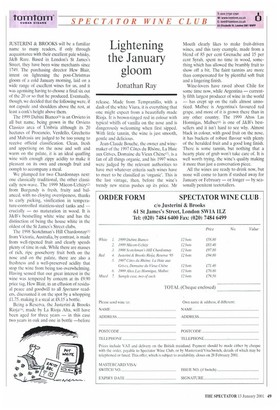Lightening the January gloom
Jonathan Ray
JUSTERINI & BROOKS will be a familiar name to many readers, if only through acquaintance with their excellent pale whisky, J&B Rare. Based in London's St James's Street, they have been wine merchants since 1749. The purchasing director Hew Blair, intent on lightening the post-Christmas gloom of a cold January morning, laid on a wide range of excellent wines for us, and it was agonising having to choose a final six out of the 20 or so that he produced. Eventually, though, we decided that the following were, if not capsule and shoulders above the rest, at least a cork's height above them.
The 1999 Dubini Bianco(i) is an Orvieto in all but name, being grown in the Orvieto Classico area of Umbria although its 20 hectares of Procancio, Verdello, Grechetto and Malvasia are judged to be too young to receive official classification. Clean, fresh and appetising on the nose and soft and warm on the palate, it is an ideal quaffing wine with enough zippy acidity to make it pleasant on its own and enough fruit and oomph to accompany a meal.
We plumped for two Chardonnays next: one classically traditional, the other classically new-wave. The 1999 Mâcon-Uchizy(2) from Burgundy is fresh, fruity and balanced, with no cloying overripeness, thanks to early picking, vinification in temperature-controlled stainless-steel tanks and — crucially — no maturation in wood. It is J&B's bestselling white wine and has the distinction of being the house white in the oldest of the St James's Street clubs.
The 1998 Scotchman's Hill Chardonnay(3) from Victoria, Australia, by contrast, is made from well-ripened fruit and clearly spends plenty of time in oak. While there are masses of rich, ripe gooseberry fruit both on the nose and on the palate, there are also a freshness and a well-preserved acidity that stop the wine from being too overwhelming. Having sensed that our great interest in the wine was tempered by concern at its £9.90 price tag, Hew Blair, in an effusion of residual peace and goodwill to all Spectator readers, discounted it on the spot by a whopping £1.75, making it a steal at £8.15 a bottle.
Being a Resema, the Justerini & Brooks Rioja(4), made by La Rioja Alta, will have been aged for three years — in this case two years in oak and one in bottle —before release. Made from Tempranillo, with a dash of the white Viura, it is everything that one might expect from a beautifully made Rioja. It is brown-tinged red in colour with typical whiffs of vanilla on the nose and is dangerously welcoming when first sipped. With little tannin, the wine is just smooth, gentle and delicious.
Jean-Claude Bouche, the owner and winemaker of the 1997 Cotes du Rhone, La Hair aux Grives, Domaine du Vieux Chene(5), is a fan of all things organic, and his 1997 wines were judged by the relevant authorities to have met whatever criteria such wines have to meet to be classified as 'organic'. This is the last vintage, then, before the wine's trendy new status pushes up its price. Mr
Mouth clearly likes to make fruit-driven wines, and this tasty example, made from a blend of 85 per cent Grenache and 15 per cent Syrah, spent no time in wood, something which has allowed the brambly fruit to show off a bit. The faint tannins arc more than compensated for by plentiful soft fruit and a lingering finish.
Wine-lovers have raved about Chile for some time now, while Argentina — currently fifth largest producer of wine in the world — has crept up on the rails almost unnoticed. Malbec is Argentina's favoured red grape, and more of it is grown there than in any other country. The 1999 Altos Las Hormigas. Malbec(6) is one of J&B's bestsellers and it isn't hard to see why. Almost black in colour, with good fruit on the nose, it has buckets of robust flavour with plenty of the heralded fruit and a good long finish. There is some tannin, but nothing that a hearty plate of grub won't take care of. It is well worth trying, the wine's quality making it more than just a conversation piece.
All the wines are ready to drink now, but none will come to harm if stashed away for January or February — or longer — by seasonally penitent teetotallers.






























































 Previous page
Previous page